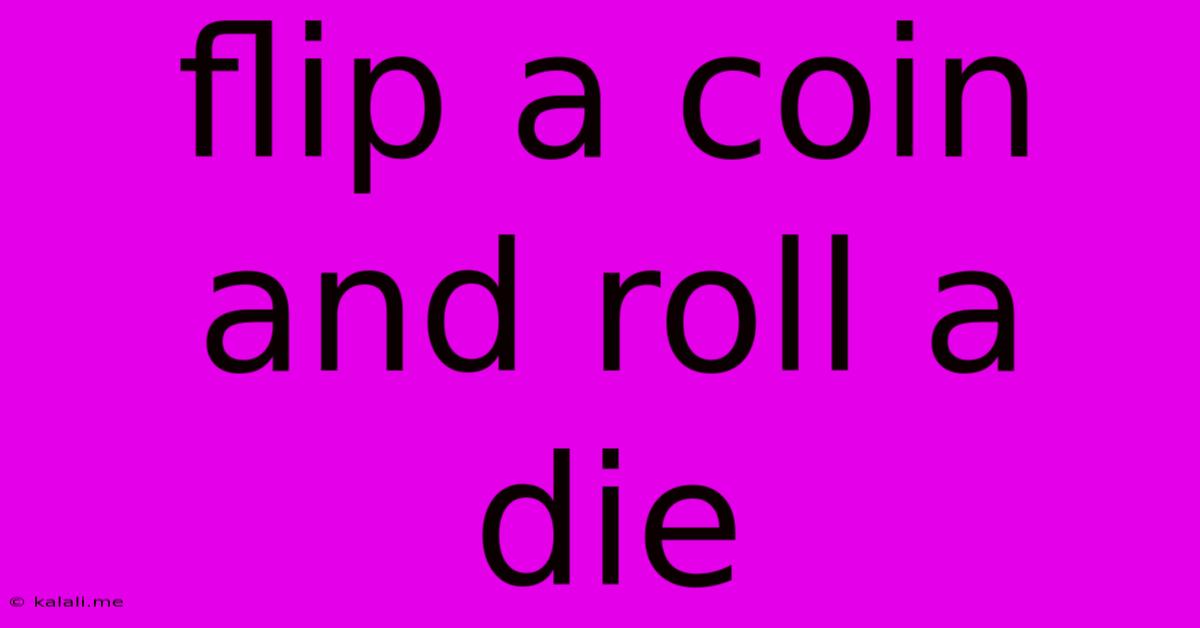Flip A Coin And Roll A Die
Kalali
May 21, 2025 · 3 min read

Table of Contents
Flip a Coin and Roll a Die: Understanding Probability and Combinations
This article delves into the seemingly simple act of flipping a coin and rolling a die, exploring the underlying principles of probability and the different combinations possible. Understanding these fundamentals is crucial for anyone studying statistics, probability, or even just curious about the mathematics of chance. We'll cover calculating probabilities, visualizing outcomes, and exploring the applications of these basic concepts in more complex scenarios.
Understanding the Basics: Independent Events
Flipping a fair coin and rolling a fair six-sided die are considered independent events. This means the outcome of one event doesn't affect the outcome of the other. The probability of getting heads on a coin flip remains 50% regardless of whether you roll a 3 or a 6 on the die. This independence is key to calculating the overall probability of combined outcomes.
Possible Outcomes: The Sample Space
Let's define the sample space – the set of all possible outcomes. For a coin flip, the sample space is {Heads, Tails}. For a die roll, the sample space is {1, 2, 3, 4, 5, 6}.
When we combine these events, the sample space expands significantly. We can represent each outcome as an ordered pair (Coin Result, Die Result). This gives us a total of 12 possible outcomes:
- (Heads, 1)
- (Heads, 2)
- (Heads, 3)
- (Heads, 4)
- (Heads, 5)
- (Heads, 6)
- (Tails, 1)
- (Tails, 2)
- (Tails, 3)
- (Tails, 4)
- (Tails, 5)
- (Tails, 6)
Calculating Probabilities: Simple and Combined Events
The probability of a single event is calculated as:
Probability = (Favorable Outcomes) / (Total Possible Outcomes)
- Probability of getting Heads: 1/2 (or 50%)
- Probability of rolling a 3: 1/6
To calculate the probability of both events happening (e.g., getting Heads and rolling a 3), we multiply the individual probabilities because the events are independent:
Probability (Heads and 3) = Probability (Heads) * Probability (3) = (1/2) * (1/6) = 1/12
This means there's a 1/12 chance of getting Heads on the coin flip and a 3 on the die roll. You can apply this same principle to calculate the probability of any combination of coin flip and die roll outcomes.
Exploring More Complex Scenarios: Conditional Probability
While the coin flip and die roll are independent, introducing conditional probability opens up more intricate possibilities. For example, what if we only consider outcomes where the die roll is even? This introduces a condition that affects the overall probability. We would only consider the six outcomes involving an even number on the die. The probability of getting Heads given an even die roll would then be 1/3 (as there are three favorable outcomes out of a total of six).
Applications and Further Exploration
The simple act of flipping a coin and rolling a die provides a foundational understanding of probability and its applications. These principles extend to many areas, including:
- Game theory: Analyzing the odds in various games of chance.
- Statistics: Understanding data distributions and making inferences.
- Risk assessment: Evaluating the likelihood of different outcomes in various situations.
- Computer science: Simulating random events and developing algorithms.
By grasping the fundamentals illustrated here, you can build a solid base for exploring more advanced concepts in probability and statistics. This includes learning about binomial distributions, expected value, and more complex probability models. Further exploration will allow you to confidently tackle a wide range of problems involving uncertainty and chance.
Latest Posts
Latest Posts
-
Pit Bull And Bull Terrier Mix
May 22, 2025
-
Can You Put Aerosols In Hold Luggage
May 22, 2025
-
How To Get Oil Off The Wall
May 22, 2025
-
How Deep Should A French Drain Be
May 22, 2025
-
Can I Drink Tap Water In Spain
May 22, 2025
Related Post
Thank you for visiting our website which covers about Flip A Coin And Roll A Die . We hope the information provided has been useful to you. Feel free to contact us if you have any questions or need further assistance. See you next time and don't miss to bookmark.